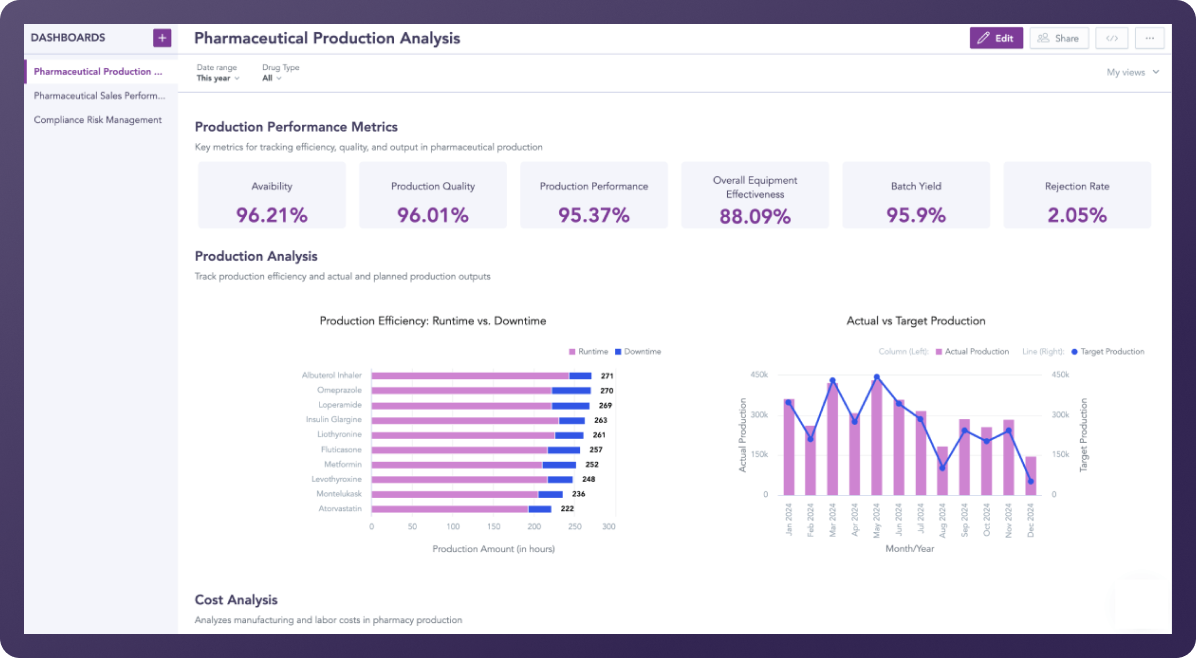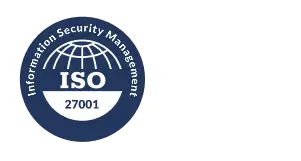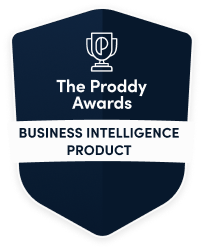Advanced analytics for pharmaceutical & life sciences companies
Improve clinical programs and operations through data-driven decisions.

Revolutionize your operations with advanced/AI-assisted analytics software

Improve R&D efficiency
- Analyze vast datasets, such as clinical trial data, historical drug performance, and genetic information to inform drug development decisions.
- Predict drug success by analyzing past research and clinical trial patterns to reduce R&D time and costs.

Enhance clinical trials
- Identify suitable candidates for clinical trials and improve recruitment speed and retention rates.
- Monitor trial data in real-time, allow for quicker adjustments to study protocols, and improve the safety and efficacy of the assessment process.

Reduce compliance risk
- Streamline the preparation and submission of regulatory documents, minimizing errors and the time required for compliance.
- Get advanced data analytics and visualization capabilities, and gain insight into any regulatory risk associated with global supply chains..
- Save time and increase efficiency in reducing compliance risk.

Increase operational efficiency
- Optimize processes such as manufacturing and supply chain management to reduce operational costs.
- Gain easier access to actionable insights with fast analytics, at scale.
- Discover and share hidden insights, encourage collaboration across multiple teams, and improve internal analytics capabilities.
Dive deep into our success stories
Examples of pharmaceutical & life sciences dashboards
See how organizations are leveraging pharma & life science insights.

Track pharmaceutical production
Indicators such as runtime vs, downtime, availability, quality, and batch yields provide a high-level overview of pharmaceutical production.
- Drill into data for further insights.
- Multiple visualization options to emphasize key figures.

Sales performance at a glance
A powerful tool designed to streamline and enhance sales operations. A pharmaceutical sales dashboard provides real-time insights into key metrics such as sales performance, market trends, and customer engagement.
- Easy to share with management and stakeholders.
- Fully customizable to match your brand.
Discuss your use case with us
See how GoodData can help with your analytics goals.
Why choose our analytics platform?
Reasons why companies love our analytics platform include:
Smoothly implement in your ecosystem



Deploy in GoodData Cloud
GoodData Cloud is a SaaS product operated and maintained by us. Customers receive continuous code updates and it can be deployed in AWS, Azure, and multi-region.



Deploy Self-hosted
Self-hosted uses the same codebase as GoodData Cloud and is ideal for users needing enhanced security, governance, or control for data residency or regulatory compliance.





Integration
Open APIs and declarative SDKs — connect to code repositories and 3rd-party apps, embed anywhere.




Security and governance
Trusted analytics — certifications, inherited permissions, and cascading content changes for easy admin.




Accessibility
Accessible analytics — ensuring compliance and delivering inclusive experiences.




















A trusted platform, loved by users






FAQs about pharmaceutical & life sciences analytics
An analytics tool can offer numerous benefits across various aspects of the pharmaceutical industry, ranging from research and development to supply chain management and patient outcomes. Here are some key advantages:
- Improved Research and Development (R&D) Efficiency: Pharmaceutical analytics tools allow companies to analyze vast datasets, such as clinical trial data, historical drug performance, and genetic information. This leads to more informed decisions in drug development.
- Enhanced Clinical Trials: Pharma analytics tools can analyze patient data to identify suitable candidates for clinical trials, improving recruitment speed and retention rates.
- Optimized Manufacturing: Analytics can predict drug demand based on historical data, market trends, and epidemiological models, helping to optimize production schedules.
- Higher Supply Chain Efficiency: By analyzing supply chain data, pharma companies can identify inefficiencies, reduce waste, and improve the overall flow of products from manufacturing to distribution.
- Improved Regulatory Reporting: Automated reporting features streamline the preparation and submission of regulatory documents, reducing errors and the time required for compliance.
- Better Patient Outcomes: Analytics enable the development of personalized treatment plans based on patient data, improving treatment efficacy and reducing adverse effects.
- Operational Efficiency: Pharmaceutical analytics tools help reduce operational costs by optimizing processes such as R&D, manufacturing, and supply chain management.
- Reduced Time to Market: Streamlining processes through data-driven insights reduces the time it takes for a drug to go from development to market, further reducing costs.
- Cross-Departmental Insights: Analytics tools facilitate collaboration across different departments by providing a unified view of data, leading to more cohesive and informed decision-making.
- External Collaboration: Pharma companies can collaborate with external partners, such as research institutions or other companies, by sharing insights derived from analytics, fostering innovation.
There are several things to consider when deciding on an analytics tool. Here's a step-by-step guide to help you make the right choice for your pharma use case:
- Define your requirements: Start by clearly defining your analytics requirements. Identify the specific use cases and key performance indicators (KPIs) you want the BI tool to support.
- Evaluate features and functionality: Look for BI tools that offer features and functionality tailored to pharma analytics. Key features to consider include data visualization options, ad-hoc reporting, predictive analytics, drill-down capabilities, and rich integration options.
- Scalability and flexibility: Choose a BI tool that can scale as your requirements change. Consider whether the tool supports flexible data integration from multiple sources.
- Ease of use: Choose a BI tool that is user-friendly and intuitive, allowing pharma and life sciences professionals with varying levels of expertise to easily access and analyze data. Look for features such as drag-and-drop interfaces, customizable dashboards, and self-service analytics capabilities.
- Data security and governance: Look for a tool that meets the highest standards of data security and privacy. HIPAA compliance should be a must.
- Vendor reputation and support: Read customer reviews, case studies, and analyst reports to assess the vendor's reliability, customer satisfaction, and level of support.
- Cost considerations: Evaluate the BI tool's total cost of ownership (TCO), including licensing fees, implementation costs, training expenses, and ongoing support and maintenance costs. Choose a tool that offers transparent pricing and meets your budget constraints.
The following features enable pharma organizations to extract meaningful insights from their data and use those insights to improve operational efficiency and sales performance:
- Predictive modeling: Uses historical data, machine learning algorithms, and statistical models to predict outcomes, such as drug efficacy, market demand, or patient responses.
- Machine learning and AI: This feature can analyze large datasets, learn from data patterns, and improve over time. Machine learning and AI are crucial for drug discovery, better R&D processes, and optimizing clinical trials.
- Data visualization: Provides interactive dashboards and reports that make complex data understandable at a glance. Visualization tools are essential for tracking performance metrics, identifying trends, and communicating findings to stakeholders.
- Real-time analytics: Offers the ability to analyze and report on data as it is received.
- Interoperability and data integration: This helps integrate data across various pharmaceutical systems and devices, ensuring that data is complete, accurate, and available when and where it's needed for care.
- Regulatory compliance and data governance: Ensures that analytics solutions comply with necessary regulations. Features include data encryption, access controls, audit trails, and consent management.
- Security and privacy protection: Advanced security measures protect sensitive patient data against unauthorized access, breaches, and other cyber threats. These measures include encryption, anomaly detection, and multi-factor authentication.
- Cloud-based analytics: Scalable, flexible solutions are hosted on cloud platforms, giving healthcare organizations powerful analytics capabilities without significant upfront investments in IT infrastructure.














